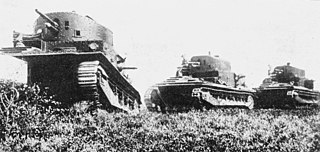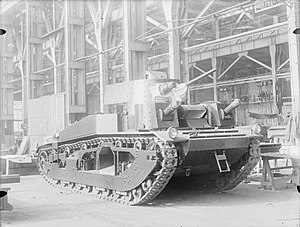
The Infantry Tank Mark II, better known as the Matilda, is a British infantry tank of the Second World War.

The Vickers 6-ton tank or Vickers Mark E, also known as the "Six-tonner", was a British light tank designed in 1928 in a private project at Vickers. Though not adopted by the British Army, it was picked up by several other armed forces, and licensed by the Soviet Union as the T-26. It was also the direct predecessor of the Polish 7TP tank.

The Tank, Infantry, Mk III, Valentine was an infantry tank produced in the United Kingdom during World War II. More than 8,000 of the type were produced in eleven marks, plus various specialised variants, accounting for approximately a quarter of wartime British tank production. The many variants included riveted and welded construction, petrol and diesel engines and a progressive increase in armament. It was supplied in large numbers to the USSR and built under licence in Canada. It was used extensively by the British in the North African campaign. Developed by Vickers, it proved to be both strong and reliable.

Crusader, in full "Tank, Cruiser Mk VI, Crusader", also known by its General Staff number A.15, was one of the primary British cruiser tanks during the early part of the Second World War. Over 5,000 tanks were manufactured and they made important contributions to the British victories during the North African campaign. The Crusader tank would not see active service beyond Africa but the chassis of the tank was modified to create anti-aircraft, fire support, observation, communication, bulldozer and recovery vehicle variants.

The Tank, Cruiser, Mk I (A9) was a British cruiser tank of the interwar period. It was the first cruiser tank: a fast tank designed to bypass the main enemy lines and engage the enemy's lines of communication, as well as enemy tanks. The Cruiser Mk II was a more heavily armoured adaptation of the Mark I, developed at much the same time.

The FV4201 Chieftain was the main battle tank (MBT) of the United Kingdom from the 1960s into 1990s. When introduced, it was among the most heavily armed MBTs of the era, mounting a 120 mm Royal Ordnance L11 gun, the equal of the much larger specialist heavy tanks then in service. It also was among the most heavily armoured, with up to 195 mm (7.7 in) that was highly sloped to offer 388 mm (15.3 in) thickness along the line of sight.

AEC Armoured Car is the name of a series of British heavy armoured cars built by the Associated Equipment Company (AEC) during the Second World War.

The Tank, Infantry, Valiant (A38) was a British tank design of the Second World War that only reached the prototype stage. It was intended to meet a specification for a well-armoured, light-medium tank, for use against Japanese forces in the South-East Asia theatre. The prototype demonstrated that the design was a failure and this sole example produced was retained by the School of Tank Technology as a lesson to its students.

The AMC 34 was a French tank originally built for the French Army's cavalry units. Its production was cut short, and the few vehicles produced were out of service by the time of the Battle of France in the Second World War.

The Light Tank Mark I to Mark V were a series of related designs of light tank produced by Vickers for the British Army during the interwar period.

The T-44 was a medium tank developed and produced near the end of World War II by the Soviet Union. It was the successor to the T-34, offering an improved ride and cross-country performance, along with much greater armor. Designed to be equipped with an 85 mm main gun, by the time it was fully tested the T-34 had also moved to this weapon. Both tanks offered similar performance, so introducing the T-44 was not considered as important as increasing T-34 production. Fewer than 2,000 T-44s were built, compared to about 58,000 T-34s. Although the T-44 was available by the end of the war, it was not used in any battle. It was 1 ton lighter than the T-34-85 and slightly faster. The T-44 was heavily influential on the design of the T-54/55 main battle tank, most prominently lower hull and turret profiles. Also notable was the T-44-100, a 100mm D-10T-armed prototype, which would be the same 100mm gun mounted on the T-54/55, bar some minor changes.

Tanks were initially deployed in World War I, engineered to overcome the deadlock of trench warfare. Between the two world wars, tanks were further developed. Although they had demonstrated their battlefield effectiveness, only a few nations had the industrial resources to design and build them. During and after World War I, Britain and France pioneered tank technology, with their models generally serving as a blueprint for other countries. However, this initial advantage would slowly diminish during the 1930s, shifting in favor of the Soviet Union and, to a lesser degree, Nazi Germany.

The Marmon-Herrington Armoured Car was a series of armoured vehicles that were produced in South Africa and adopted by the British Army during the Second World War. RAF Armoured Car companies possessed them, but seem never to have used them in action, making greater use of Rolls-Royce Armoured Cars and other types.

The Vickers Medium Mark II was a British tank built by Vickers in the Inter-war period.

The Vickers Medium Mark I was a British tank of the Inter-war period built by Vickers from 1924.

The Hotchkiss H35 or Char léger modèle 1935 H was a French cavalry tank developed prior to World War II. Despite having been designed from 1933 as a rather slow but well-armoured light infantry support tank, the type was initially rejected by the French Infantry because it proved difficult to steer while driving cross-country, and was instead adopted in 1936 by the French Cavalry arm.

The Char D1 was an Interwar French light tank.

The Vickers T-15 light tank, full designation Char Léger de Reconnaissance Vickers-Carden-Loyd Mod.1934 T.15, was a light 4-ton tank of the Belgian Army. They were built by Vickers-Armstrong in the UK to the design of their Light Tank Mark III and outfitted with their armament in Belgium by Fonderie Royale de Canons (FRC) at Herstal. It entered service in 1935, and was used by the Belgian Army during the Battle of Belgium in May 1940. Its main armament was a 13.2 mm Hotchkiss machine gun. The tank was intended as a replacement for the venerable but obsolescent Renault FT. Only 42 were produced.

The Type 87 Chi-I medium tank a/k/a Experimental tank No.1 was the first indigenously designed tank produced by Japan for the Imperial Japanese Army. Development of this medium tank began in June 1925 and was completed by February 1927. During the field trials, the tank proved to be too heavy and under-powered. The project was cancelled and a new light tank design was finished by April 1928 and designated the Type 89 I-Go.
The Vickers Medium Dragon was a fully-tracked British field artillery tractor made by Vickers, produced in various versions from 1922 to 1937. The Medium Dragon towed a wide range of artillery, from 18-pounder field guns to BL 60-pounder heavy field guns. It was developed from the carrier version of a 'Tropical Tank' designed by Lt-Colonel Philip Johnson, using components from the running gear of the Vickers Medium Mark I tank.




















